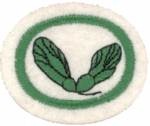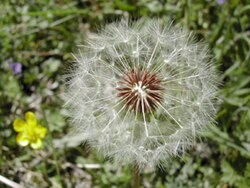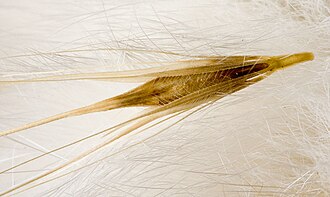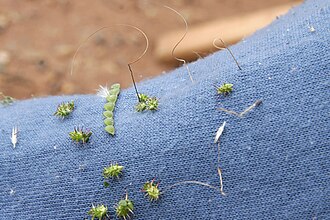AY Honors/Seeds/Answer Key/es
| Semillas | ||
|---|---|---|
| Asociación General
|
Destreza: 1 Año de introducción: 1961 |
|
Requisitos
|
La especialidad de Semillas es un componente de la Maestría Naturaleza. |
| Conexión Logros para la Investidura: Esta especialidad está relacionada con los requisitos de Logros para la Investidura para AMIGO Estudio de la naturaleza que requiere (como una de dos opciones) hacer una colección de 15 diferentes clases de semillas como está escrito en el requisito #9 de esta especialidad. Esta especialidad es una elección popular para la especialidad de la categoría de Estudio de la naturaleza de nivel de destreza 1 requerido para los AMIGOS DE LA NATURALEZA. |
1
2
3
4
Gravity
The effect of gravity on the dispersal of seeds and spores is straightforward. Heavier seeds will tend to drop downward from the parent plant, and not by themselves travel very far. Spores, being much lighter, are more influenced by physical movements in the environment, especially those of wind and water, and therefore less strictly subject to the simple motion of gravity (see examples below). Gravity may be sufficient agent for plants growing on steep slopes, but upslope movement of a population can be a problem. The naked seeds of gymnosperms are largely dependent upon gravity for dispersal. Most conifers are long-lived large shrubs or tall trees, thus taking full advantage of gravitational dispersal and allowing for gradual upslope movement of a population. Dispersal of seeds "strictly" by gravity should not overlook storm effects: seeds from a deteriorating cone growing high on a tall, narrow tree will get spread widely during a wind storm (see "Wind" below).
Encasing seeds in a rounded fruit promotes gravity driven movement away from the parent.
- Pine trees
- Spruce trees
- Fir trees
- Junipers
- Cedars
- Hemlocks
Mechanical dispersal
Numerous species have mechanical means to overcome the tendency of a seed to drop close to its parent. Seedpods are often shaped so that the seeds are flung away from the parent plant with considerable force as the seedpod matures
Examples of fruit with mechanical dispersal mechanisms:
- Yellow wood sorrel and Touch-me-not – as the seed dries, becomes sensitive to disturbance, ejecting tiny seeds in an explosive discharge. Touch-me-not is named for this behavior.
- Maple trees - the seeds of the Maple tree are those little "helicopters" that children love to play with. As the seeds falls, the wings cause it to rotate, slowing its descent, and thus allowing a breeze to carry it farther from the parent. When the seed strikes the ground, it bores into the soil.
Wind
For non-aquatic, terrestrial plants, the wind is an obvious supplier of energy for movement, and many plants clearly take advantage of this fact. This type of seed dispersal is not efficient, but very effective. Perhaps most familiar are the feather-light fiber parachutes with attached achenes that are produced by a number of species of flowers, a well-known example being the dandelion (see right).
- Milkweed
- Thistles
- Dandelions
Water
Plants that grow in water (aquatic and obligate wetland species) are likely to utilize water to disperse their seeds. For example, all mangroves disperse their offspring by water. In one mechanism, the seedling separates from the fruit, leaving its cotyledons behind, and—floating horizontally on the water surface—is carried away by tidal or river flow. After a month or two, the propagated seed turns vertical in the water. Once it "feels" bottom or strands, roots start to develop and leaves appear at the upper end.
A mechanism commonly seen in coastal plants are those that promote flotation of the fruit, allowing the seed to be carried away on the tide or ocean currents. Examples would be:
- The coconut produces a large, dry, fiber-filled fruit capable of a long survival adrift at sea.
- Alexandrian laurel or kamani produces a globose fruit that is almost cork-like.
Animals
A significant aspect of plant-animal cooperation involves plants designed to take advantage of animal abilities to move. Some fruit have prickly burrs or spikes that attach themselves to a passing animal's fur or feathers so that the animal will carry them away. Some seeds are contained within a soft fruit that "invites" animals to consume it. These seeds have a tough protective outer-coating so that while the fruit is digested, the seeds will pass through their host's digestive tract intact, and grow wherever they fall. Some seeds are appealing to rodents (such as squirrels) who hoard them in hidden caches, often beneath the surface of the soil, in order to avoid starving during the winter and early spring. Those seeds that are left uneaten have the chance to germinate and grow into a new plant.
Some animals that disperse may also eat the seed.
- Beggarlice
- Cockle burr
- Apple
- Banana
- Strawberry
- Oak (acorns)
5
6
7
8
Stratification mimics natural processes that weaken the seed coat before germination. In nature, some seeds require particular conditions to germinate, such as the heat of a fire (e.g., many Australian native plants), or soaking in a body of water for a long period of time. Others have to be passed through an animal's digestive tract to weaken the seed coat and enable germination.
9
References
- Wikipedia articles
- Categoría: Tiene imagen de insignia
- Adventist Youth Honors Answer Book/Honors/es
- Adventist Youth Honors Answer Book/es
- Adventist Youth Honors Answer Book/Skill Level 1/es
- Categoría: Libro de respuestas de especialidades JA/Especialidades introducidas en 1961
- Adventist Youth Honors Answer Book/General Conference/es
- Adventist Youth Honors Answer Book/Nature/es
- Adventist Youth Honors Answer Book/Nature/Primary/es
- Adventist Youth Honors Answer Book/Stage 0/es
- Adventist Youth Honors Answer Book/Naturalist Master Award/Flora/es
- Adventist Youth Honors Answer Book/IAConnection/es
- Adventist Youth Honors Answer Book
- Adventist Youth Honors Answer Book/Do at home





